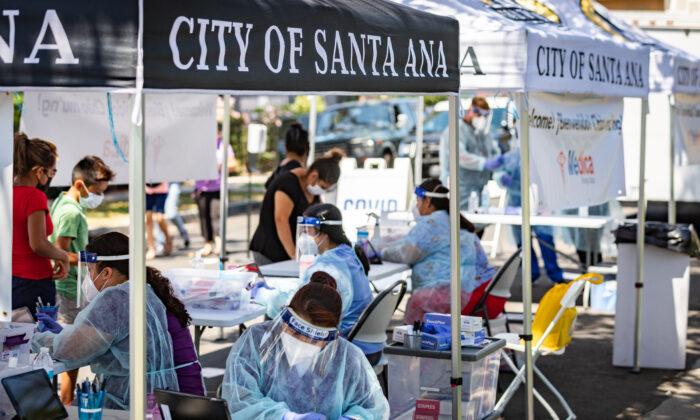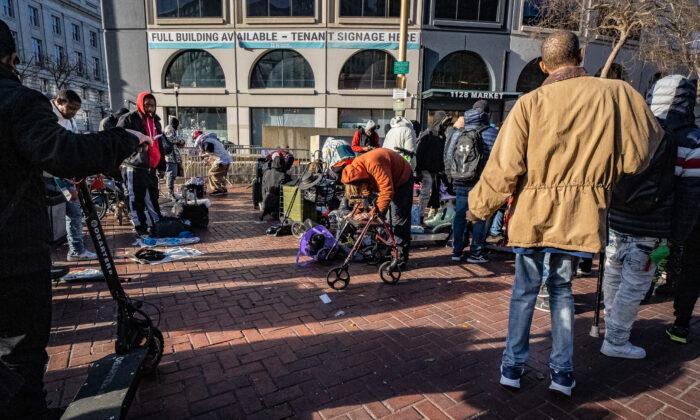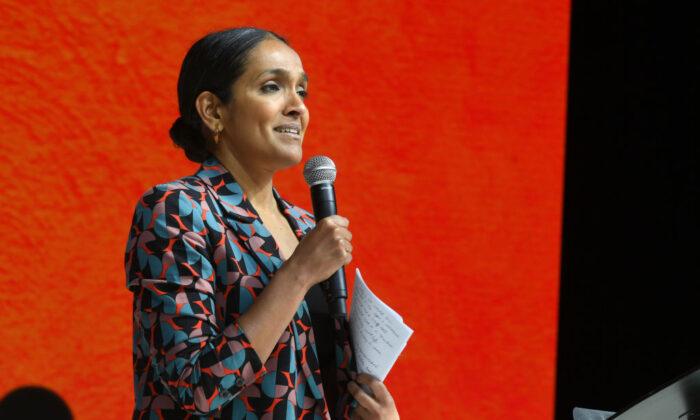ANAHEIM, Calif.—Maritza Bermudez, who works at the nonprofit Latino Health Access clinic in Anaheim, California, pointed to the homes behind the clinic and told The Epoch Times, “It’s a very high density area, low income, and it’s been very hit with COVID-19. There’s been a couple of deaths on that street.”
Latino Health Access is a nonprofit organization with facilities in Anaheim and Santa Ana helping the Latino community, which has its unique challenges in the fight against the disease.
Professors at the UCLA Fielding School of Public Health reported Aug. 27 that COVID-19 deaths among working-age Latinos in California have increased nearly five-fold in the past three months. Among cities in Orange County, Santa Ana has the most cases—more than 9,300 as of Aug. 29—followed by Anaheim, at over 8,200. Santa Ana is more than 75 percent Latino, while Anaheim is about 55 percent.
Story continues below advertisement
Bermudez’s site provides free COVID testing, but even with its proximity to the Latino community that needs it, she said many barriers still prevent that community from accessing the help.

A free, drive-through COVID-19 testing site operated by the nonprofit Latino Health Access at St. Anthony Claret Catholic Church on La Palma Ave. in Anaheim, Calif., on Aug. 25, 2020. John Fredricks/The Epoch Times

Teledentist Parsia Jahanbani hands COVID-testing swabs to medical personnel at a free clinic operated by Latino Health Access in Anaheim, Calif., on Aug. 25, 2020. John Fredricks/The Epoch Times
The Barriers
“If you have COVID, quite often they don’t tell anybody, like they just tough it out,” she said. “They don’t want to tell anybody about it. … [Some of them are] the breadwinners bringing the income to the home.”She said people are living in close quarters, with multi-generational households squeezed into small homes.
“They’re not looking for services. They don’t usually have a medical provider; they don’t have insurance,” Bermudez said.
Story continues below advertisement
Some are worried about giving their information for contact tracing out of fear the information will be shared with Immigration and Customs Enforcement, leading to deportation.
Without identification, many also think they’ll be denied testing.
The Support
The Santa Ana City Council approved $28.6 million in federal Coronavirus Aid, Relief, and Economic Security (CARES) Act funding earlier this month to provide testing and outreach in the city. The Santa Ana CARES Mobile Resource Center was established with that funding and launched on Aug. 26.About 50 percent of Santa Ana residents don’t have personal vehicles and 20 percent don’t have internet access, according to Santa Ana CARES. That makes it difficult to get to testing sites, or access information about testing and other resources. So the mobile resource center brings help to them.
Orange County Supervisors Andrew Do and Doug Chaffee began the Latino Health Equity Initiative in Santa Ana and Anaheim on June 30 to address COVID spread in those communities. It’s overseen by Latino Health Access, which has provided outreach on various health issues since 1993.
Story continues below advertisement
It uses a squad of promotores, or promoters, to connect the Latino community with the resources it needs. The promotores are part of the community, so they are trusted and as a result, might get the information out more easily, while government agencies might inspire mistrust. They range in age from 6 to 76, according to the organization’s website.
The Promotores
Veronica Mondrago also works at Latino Health Access’s site at the St. Anthony Claret Catholic Church in Anaheim.“The promotores do a really good job in establishing a relationship with the people,” she told The Epoch Times. “This is confidential, you know. It has nothing to do with immigration; it has nothing to do with whether you have papers. It is for the safety of the community, for the safety of your family, so that people can open up.”
Regarding collecting information for contact tracing, she said it’s kept confidential and only used to reach out to people if they have come in contact with someone with COVID-19.
“Sometimes, we find out that people, they don’t just need tests,” she said. “They need resources, they need food, they need a place to stay, because they don’t have a safe place to quarantine in their home. So we have been helping with those resources.”
Story continues below advertisement

Care Coordinator Haidee Hernandez helps register two walk-in patients for COVID-19 testing at a free testing center operated by Latino Health Access in Anaheim, Calif., on Aug. 25, 2020. John Fredricks/The Epoch Times
Bermudez said, “It’s also about shedding light on the big issues about affordable housing.
“How many people would be spared from getting COVID, just because they … [would] have a home for themselves, versus being everybody coming into your home living in a two-bedroom or one-bedroom?” she added.





